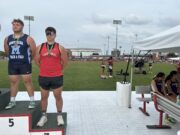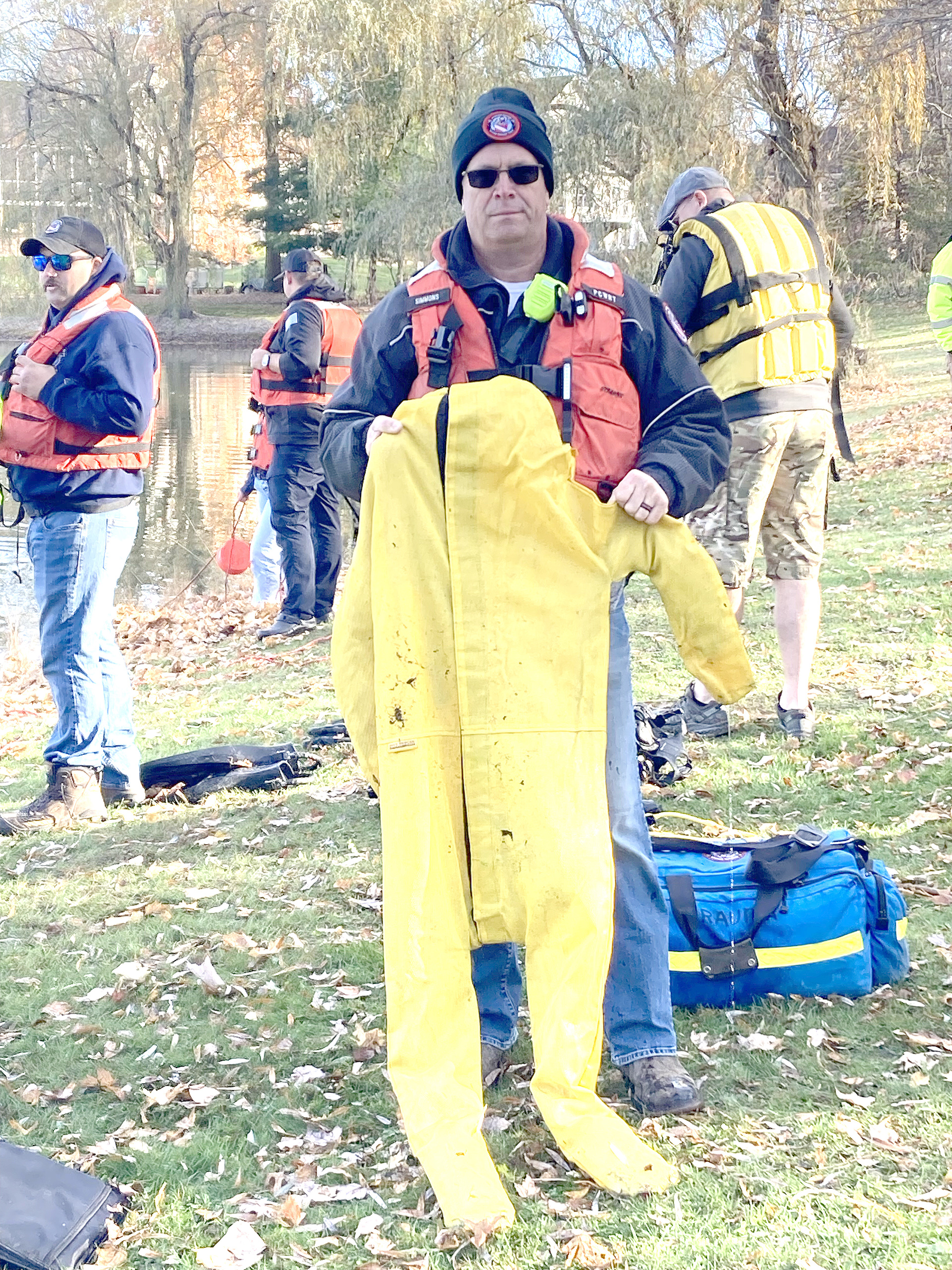So, the Portage County Water Rescue Team heroes have had a busy Autumn. They have graciously invited this reporter to attend some of their training. Originally, I was going to observe Boat Rescue Training to be held at West Branch, but that was canceled due to the possibility of storms. No worries, they have plenty more to attend! This is how I found myself observing as they trained in use of the AquaEye and Dive Rescue.
The AquaEye is a new piece of equipment for the team. Matt Bright led the team as they learned about this hand-held sonar scanner. It uses sonar technology and artificial intelligence to identify possible human bodies underwater and in water with limited visibility. This speeds up rescue and recovery operations by up to 90%! It also increases the safety of the team and reduces required rescue resources. Sounds like a winning combination.
The team member wears a protective Swift Water Suit as s/he is standing chest deep in the water. The AquaEye is held underwater to scan. They scan in a semi-circle around the rescuer. Then the display screen will indicate objects that have a strong likelihood of being a person with an X, and lighter objects (less likely to be a person) with an O. The range is up to 10 to 50 meters. Though it has some limitations, such as the sonar cannot pass through solid objects or air, it adds one more rescue tool to the team.
The AquaEye was passed from person to person so they could try it out on dry land, actually carpet in the Suffield Fire Department meeting room, prior to using it at an upcoming rescue training. They even gave me the opportunity to try. So, I held it at my hip and did a semi-circular scan of the room. The device was easy to hold and understand the screen, even for this technophobe.
While there, the team also analyzed a 911 call from Suffield. It was chilling for this outsider to listen to, as the Operator and the Rescue team exchanged information and progress in what was real-time for the recording. The protocol for rescue was followed by all involved, and they did rescue the person. After the use of CPR, Shock and Narcan, they were able to get a pulse and send him on to the hospital. The rescue team gave that man his best shot.
That was the easy training! Inside, warm and dry. The next training I attended…not so much. Prior to this session, classroom and book activities were held. Then, pool training. Finally, the open water…It was a beautiful but brisk day at the Twin Lakes beach, about 54 degrees and sunny. Dave Moore, former commander and Instructor for Dive Rescue International was leading the team in preparation, search patterns, and everything necessary to conduct an underwater search. Dive Rescue International is a company based in Colorado, which does 80% of the professional dive rescue training in the US.
Having been in that lake in early autumn, I knew the temperature had to be brisk, but the divers were well protected. The shore personnel would ‘dress the diver’ before they entered the water. Each diver had to have insulating lining (think like long-johns,) dry suit, ankle chains over the boot of the dive suit, gloves, hood, full face-mask with communication ability, BCD (buoyancy control device,) weight vest, gloves, hood, tank, pony tank (smaller tank with totally redundant air supply,) two cutting tools, and probably more than I can remember. All of this was followed by a Pre-Dive Checklist.
Divers were sent out in pairs; one was the searcher and the other was the safety diver, and the shore support. As the searcher did the patterns the safety diver remained at the surface for support and to communicate with shore and the diver. Both were tethered to the shore support. Three tugs were given, the signal to come up. As the searcher came out of the water, the shore personnel would ‘undress’ the diver and lead them to the bench for rest, removal of the scuba unit and a debriefing. Also, the divers had to report to the medical table for a blood pressure check and a full Neurological Exam Survey to ensure that no decompression illness (think the Bends) occurred. Then the teams were rotated.
I left as the third rotation was going in, knowing that the PCWRT would be here until everyone was trained in every job; diver, safety diver, tender, and communications. Then they would carefully stow their equipment in the team’s trailer and meet tomorrow for the next phase of training-the actual rescue simulation.
This was held in the Forest Lakes Development on Fairchild, in Kent. There is a small park there with a lake and some trails. Dave Moore submerged the ‘victim,’ then called in the ‘emergency’ at approximately 8:00am. I arrived at 8:23 to a full parking lot and a beehive of activity. Some people were doing witness interviews to get a bearing on the last time/location the ‘victim’ was seen. Divers were in the water by 8:30. The AquaEye was in use, and it did locate the item. The first diver had some equipment difficulties, so runners on the shore switched out the scuba unit. He then had to switch himself out due to equipment and health concerns. He was audibly breathing heavy. 2-3 people assisted him and he was checked out by the medical personnel. By 8:45 a new diver was in the water.
Having observed the team for two days, I was curious about just how much weight the divers were carrying. I know when I dive, I have about 40-50 pounds on my back that don’t belong to me, what do they carry? Commander Simmons took me to one of the units:
26-34 pounds of lead weight to get down, the air inside of the dry suit makes the diver very bouyant; 1 pound on each foot, they use chains, wrapped around their ankles; Tanks-about 40-50 pounds between the two.
So, about 90 pounds. Since the team is primarily made up of firefighters and law enforcement officers, the level of fitness is greater than the general population. I asked if they did any mandatory fitness conditioning to be able to carry that much and still function. He smiled and said it is “Highly recommended.”
Observing the search pattern in use is difficult as bubbles do wander. Commander Simmons explained the two most-used ones. 98% of the time using a tether, the searcher will go beyond the targeted area and go back and forth in a pie-shaped wedge pattern, getting smaller as they make their passes. Using the second pattern, such as when there is a beach, there will be two markers on shore, the tender will walk between these markers with a rope attached to the diver and the diver will do passes in about two-foot outward swimming intervals.
At 9:03 the signal was given that the ‘victim’ was found. In actuality it was a weighted yellow dive suit…by 9:15 the team was packing up and heading to the station for a debriefing. Everyone passed this course, and now the team has 38 Rescue Divers.
I stuck around to talk to the ‘witnesses.’ Earlier in the morning, they had been briefed by Dave and given the scenario. There was one witness on the far side of the pond who was given the task of directing where the ‘victim’ was last seen. There was another couple on the other side who were to be the family of the victim. All of them said that the training was organized and methodical. Someone had even seen me and asked if I was press. If this were an actual emergency, the team would set up a press area where a liaison would update everyone at about 30-minute intervals.
It does help ease your mind to know that this level of commitment is held by so many people! The PCWRT is made up of men and women of a variety of ages and backgrounds. If you would like to learn more about them, go to their Facebook Page and give them a like. Portage County and the surrounding area are fortunate to have this team. The Superheroes will continue their training-they train every month! We hope they never have to use it in a real-life situation, but know they will. They are ready.


















